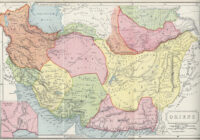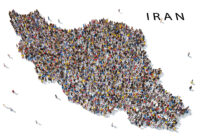It appears that it was not only the dancing that was controversial, but the dancing with all of its “Western trappings.”
In early July, a teenage dancer from Iran, Maedeh Hojabri, was detained for posting photos and videos of herself dancing on Instagram. There are several frameworks for understanding Hojabri’s arrest. The dominant interpretation is that the arrest demonstrates the extent to which Iranian authorities impose their cultural dictates on Iran’s youth, and that the regime is, in the words of Jason Rezaian, trying to “stamp out the sensual and feminine aspects of national identity.”
But you can see this story through a different lens by moving away from the physicality of dance; that is, beyond dance as an expression of social behavior and aesthetic norms and values. Only a few months short of the 40th year anniversary of the Iranian Revolution, the focus should be on the broader ideological and political ramifications of the arrest.
Even if dance can be artificially separated from its social context and considered solely in its physical features as an art form, the social component is implicit to the dancer as an individual and as a member of a socio-cultural community. Bearing this in mind, one may suggest that Hojabri was arrested for embodying the malaise of “Westoxication” (Gharbzadegi) — a term coined by the Heideggerian philosopher Ahmad Fardid and later elaborated by the intellectual Jalal al-e Ahmad to describe fascination with, and dependence on, the West to the detriment of Iran’s traditional cultural heritage.
Indeed, as Rezaian (former Washington Post Tehran bureau chief who spent 18 months in jail in Iran on espionage charges) asserts, “she might have been picked for a television talent competition show.” A talent show, indeed — America’s Got Talent, Britain’s Got Talent, The X-Factor, The Voice — all Western productions, reflecting the globalization of popular Western culture.
Ideological Baggage
Dance, as an artistic means of expression, or as a form of social interaction, is inscribed with social and political meaning, especially in West Asia and North Africa. Manipulated by the Orientalist agenda, Western representations of belly dance in literature and culture, for example, reflect how something as innocuous as dance can carry heavy ideological baggage.
The complex ways in which belly dance has been mythologized, represented and constructed in colonial travel writing, fiction, art and images from popular culture demonstrate that dance can produce social and political meaning. The term itself, danse du ventre, for instance, is fraught with political meaning, apparently denoting the French colonial conquest of Algeria and Tunisia. The term is said to be “redolent with imperial soldiers’ heterosexual pursuit of hedonist fulfilment on colonized subjects’ bodies.”
Without traversing through the complex politics of nationhood and sexual identity, Hojabri’s dancing body can be designated as a site of resistance not only for women (at the intersection of gender politics, female empowerment and sexuality), but also for the Islamic Republic itself.
In the former Soviet Union, blue jeans were once a symbol of Western culture, capitalism, consumerism and consumption — hence they were banned. Rock music was also prohibited in the USSR due to its perceived subversive effects. A blacklist of foreign bands and artists was drawn up and disseminated by the Komsomol, the Communist Party’s youth wing. The music and the jeans were not the problem, but the ideology behind these “products,” which gained significance as social and political markers during the Cold War, was. These symbols were instrumentalized in propping up the Iron Curtain.
Cultural Imperialism
This dialectic is echoed in the act of cracking down on social media and on Hojabri’s dance. It is a form of harnessing the revolutionary efforts of the past to combat the historical trauma of Westoxification. Defined as indiscriminate imitation of the West, joining the twin dangers of cultural imperialism and political domination, Gharbzadegi was the Iranian invocation of a language of revolt and of cultural protectionism. The foundation of 20th-century Iranian social criticism, Gharbzadegi was articulated in response to Western expansionism and perceived cultural erosion brought about by the Pahlavi shahs’ Westernization program.
Teenage dancer, Maedeh Hojabri, was arrested in Iran. She used to record dance videos in her bedroom and upload them to her instagram with 600K followers.#مائده_هژبرى pic.twitter.com/3EDVR9veV3
— Negar (@NegarMortazavi) July 8, 2018
Anti-Western, Iranian-Islamic romanticism became the focus of cultural discourse among the opposition, which started to experiment with Islamic norms and imagery for the purpose of revolution. Intellectuals like Ali Shariati reconstituted Iranian identity in a mixture of ideas that were laden with Third World-isms, anti-colonialism, anti-imperialism and the eternal battle between justice and injustice — with the shah and the West firmly in the folds of the unjust side of that dichotomy.
While at its core, Gharbzadegi was characterized by the iconoclastic denunciation of the West, it was not anti-modern. Rather, it reflected Iran’s struggle to chart out a developmental path that was both “modern” and reflective of a sui generis historical-cultural genotype.
Conceptually, revolutionary leader Ayatollah Khomeini resolved the problem of orientation by summarizing the objectives of the revolution in his popular phrase, “Neither East nor West, only the Islamic Republic.” The legacy and trauma of Westoxication are inherent in the dialectic between revolutionary Iran and the West. Hojabri’s dancing amplified this pathology in a slow adagio spiraling through the corridors of Iran’s revolutionary history.
Her dance performances, her outfits, the urbanity of her style, her Instagram account, her followers — values, identities, concepts and indeed even technology — are all “Western” markers, making Hojabri’s dance all the more discomfiting. How would the Iranian authorities have reacted if Hojabri had performed a traditional Japanese dance? Hence, it appears that it was not only the dancing that was controversial, but the dancing with all of its “Western trappings.”
While the act of dancing itself can be a medium of resistance, so too can the dancing body be a locus of resistance. The oppression of expression in the form of dance is the projection of the regime’s older and deeper grievances. Hojabri’s arrest is another indicator of Iran’s troubled relationship with the West — a dialectic marred by history and reinforced by a host of confrontational measures — such as the abrogation of the hard-won Iran nuclear deal.
Hojabri’s dancing is condemned as the disease of Westoxification — one of the discursive pillars of the Iranian revolution. Her performance has been stifled amid a dangerous dialectical tango, and until this dialectic is choreographed more constructively, dance will have to move across the complex and uneven stage of world politics.
The views expressed in this article are the author’s own and do not necessarily reflect Fair Observer’s editorial policy.
Photo Credit: StockphotoVideo / Shutterstock.com
Support Fair Observer
We rely on your support for our independence, diversity and quality.
For more than 10 years, Fair Observer has been free, fair and independent. No billionaire owns us, no advertisers control us. We are a reader-supported nonprofit. Unlike many other publications, we keep our content free for readers regardless of where they live or whether they can afford to pay. We have no paywalls and no ads.
In the post-truth era of fake news, echo chambers and filter bubbles, we publish a plurality of perspectives from around the world. Anyone can publish with us, but everyone goes through a rigorous editorial process. So, you get fact-checked, well-reasoned content instead of noise.
We publish 2,500+ voices from 90+ countries. We also conduct education and training programs
on subjects ranging from digital media and journalism to writing and critical thinking. This
doesn’t come cheap. Servers, editors, trainers and web developers cost
money.
Please consider supporting us on a regular basis as a recurring donor or a
sustaining member.
Will you support FO’s journalism?
We rely on your support for our independence, diversity and quality.






